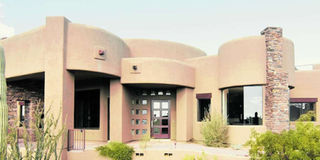Going back to the basics

Razak Nafisa with two of her children outside their new home .PHOTO| DELFHIN MUGO
What you need to know:
- Modernity aside, perhaps what Mrs Ojaamong did not know was that the decision to build Ms Ajiambo a mud house was good for a number of reasons.
- Mr Francis Gichuhi, an architect and founder of architectural firm A4 Architects, says earthen buildings have superior thermal qualities compared with other buildings.
Ms Leonida Ajiambo, a 77-year old granny from Nang’oma in Busia County, had been living in a partially collapsed, grass-thatched house for three years before well-wishers built her a semi-permanent house this year.
This was after her deplorable living conditions which, besides exposing her to severe weather conditions, meant she could only access the dilapidated house by crawling, was highlighted by the Nation.
But the house they built her is not what many people would have expected: a mud house with a corrugated iron sheet roof. Perhaps anticipating widespread criticism for not building the woman a “decent”, modern house, one of the high-profile well-wishers, Judy Ojaamong, the wife of Busia the Busia governor, Sospeter Ojaamong, said: “I understand people will ask why she was not built a brick house. The house she lived in was just a cave. Now she enters her house upright and not crawling. At least there has been some progress.”
Modernity aside, perhaps what Mrs Ojaamong did not know was that the decision to build Ms Ajiambo a mud house was good for a number of reasons. Mr Francis Gichuhi, an architect and founder of architectural firm A4 Architects, says earthen buildings have superior thermal qualities compared with other buildings.
“They are warm at night and cool during the day, creating a very conducive living environment inside the house, especially for elderly people,” Mr Gichuhi says. “On the lowest scale of heat conservation are mabati houses, which tend to be too hot during the day and freezing at night.”
Besides, a sudden change in living environment from a mud house to a stone house for an elderly person who has lived in a mud house all their life will affect them as they try to acclimatise to the new environment.
Furthermore, Mr Gichuhi notes that modern stone houses are built using materials that emit chemicals such as formaldehyde gas, which is harmful to health.
Unknown to many, mud houses have more advantages than disadvantages. First, the cost of construction is very low since the construction materials are readily available. They also have near-perfect thermal capabilities and very few hazardous chemicals are used, if any, notes Mr Gichuhi. These qualities, plus the fact that they leave few environmental footprints, given that mud houses are biodegradable when abandoned or demolished, makes mud housing more efficient and sustainable than the modern houses.
However, Mr Gichuhi notes that their main disadvantage is the relatively high maintenance cost necessitated by frequent repairs since the materials used are not strong enough to withstand day-to day use for very long.
EARTH BUILDING STANDARDS
And remarkably, mud housing is not a preserve of Third World countries or an indication of poverty or low social status. Countries like China, Peru, Turkey, and some American states even have earth building standards. Indeed, Albuquerque city in New Mexico, US, stands out in this regard. It is one of the fastest-growing, high-tech centres in the US where rich Americans have built adobe houses with all sorts of luxurious amenities. Media reports indicate that these houses are now a defining feature of the city.
“The US and South America have re-energised the use of earth as an architectural building component through earthbag housing technology. Architect Nader Khalili of the California Institute of Earth Architecture (CalEarth Institute) has dedicated a lot of resources to re-introducing earthbag houses to the US and the rest of the world,” says Gichuhi.
He adds that architect Fernando Pacheco of Brazil has also revolutionised the use of earthbag technology in South America with his hyper-adobe construction, surpassing Khalili’s super-adobe method of construction.
Though Kenya’s building code does not incorporate earthen architecture, Mr Gichuhi is confident that if well designed by an architect and supported by a structural engineer’s drawings and calculations, any county government’s would approve of this type of construction.
“With the US and South America spearheading the reintroduction of earthen architecture through earthbag technology, Kenyans, and Africans in general, will slowly embrace it, even though in Africa and rural Kenya, earthen architecture is symbolic of poverty and looked down upon.
There has been talk of sustainable development, climate change and environmental conservation that has given rise to renewed interest in earthen architecture, seen as responsive to these three factors, so is this something the government and other stakeholders should consider?
“Yes,” says Mr Gichuhi. “Earthen architecture goes a long way in conserving the environment and reducing carbon footprints in the atmosphere. With the rising cost of construction, it provides a very good solution to affordable and quality housing,” says Mr Gichuhi.
The renewed interest in building using soil led to the launch of the first International Prize for Contemporary Earthen Architecture for projects completed after 2000 at the Terra World Conference 2016, held in Lyon, France, which brought together academics, professionals and experts, and a large number of people from different backgrounds interested in building using soil.
Back home, the government has cited affordable housing among the four pillars of its development agenda, and perhaps innovation around earthen architecture, which has caught on in other parts of the world, should be given serious consideration.





